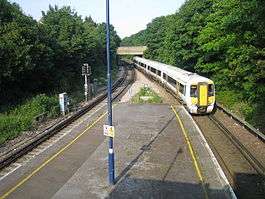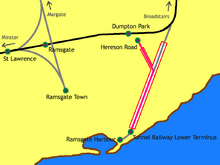Dumpton Park railway station
| Dumpton Park | |
|---|---|
 | |
| Location | |
| Place | Dumpton |
| Local authority | District of Thanet |
| Grid reference | TR386663 |
| Operations | |
| Station code | DMP |
| Managed by | Southeastern |
| Number of platforms | 2 |
| DfT category | F2 |
|
Live arrivals/departures, station information and onward connections from National Rail Enquiries | |
| Annual rail passenger usage* | |
| 2010/11 |
|
| 2011/12 |
|
| 2012/13 |
|
| 2013/14 |
|
| 2014/15 |
|
| History | |
| Key dates | Opened 19 July 1926 |
| National Rail – UK railway stations | |
| * Annual estimated passenger usage based on sales of tickets in stated financial year(s) which end or originate at Dumpton Park from Office of Rail and Road statistics. Methodology may vary year on year. | |
|
| |
Dumpton Park railway station serves the district of Dumpton between Broadstairs and Ramsgate, Kent, England, and lies on the Chatham Main Line 1 mile (1.6 km) east of Ramsgate. Train services are provided by the Southeastern train operating company.
The station has no buildings, just a few parking spaces and a bridge from the south side of the line to an island platform, with a small shelter at the bottom of the steps. Until 1965 the station served as the interchange between the main line and the nearby Tunnel Railway.
History


Following the railway grouping of 1923, both the South Eastern Railway and the London, Chatham & Dover Railway became a part of the newly formed Southern Railway, which decided to address the duplication of lines and stations at Ramsgate and Margate. The company decided to link the two lines at Ramsgate to allow through running between them. This scheme had been proposed by the South Eastern and Chatham Railway before World War I, but work did not commence until 1925.[1] This meant the closure of the terminus stations at Ramsgate Town and Ramsgate Harbour, and the construction of a line skirting the northern edge of the town to link the two existing lines. New stations on the north-eastern and north-western fringes of the town, at Dumpton Park and Ramsgate respectively, replaced the existing stations in the town centre and at the harbour.[2] Construction work on the new line involved over 700 men moving 200,000 long tons (220,000 short tons; 200,000 t) of chalk, at a cost of approximately £500,000 (£26 million in 2016).[3][4]
The new link opened on 2 July 1926 although Dumpton Park station was not fully open to the public until 19 July 1926. On 2 July 1926 both former Ramsgate stations were closed along with the line through the tunnel to Ramsgate Harbour. The tunnel was sealed and abandoned, and the former Ramsgate Harbour station was sold to Thanet Amusements, who converted it into a zoo and funfair called Merrie England.[5] Although adequate for the town's residents the new stations were a long way from the seafront attractions, which were at the foot of a steep hill. The day-trippers on whom Ramsgate's tourist industry depended were therefore increasingly attracted to Margate, where the station was next to the beach.[6]
By 1933 Merrie England, now under the ownership of Ramsgate Olympia, had become extremely popular, and Ramsgate Olympia began to lobby the Southern Railway to reopen the line through the tunnel with a new junction station between Dumpton Park and Broadstairs.[7] However, the Southern Railway rejected the proposal as too costly and impractical.[8][9] Ramsgate Olympia and the Southern Railway were keen to make the attractions near the harbour accessible from the railway main line and to provide a service from the seafront to the greyhound stadium at Dumpton Park. The two companies eventually agreed on a scheme by which a new line would use the 780 yards (710 m) of the tunnel nearest the beach, before branching off into a new 364-yard (333 m) tunnel to emerge at a new station at Hereson Road, a 250-yard (230 m) walk from Dumpton Park station.[7] Ramsgate Olympia planned the construction of a large-scale housing estate, charabanc parking facilities, and a 10,000-seat stadium at Dumpton Park to increase passenger numbers and encourage people to use the new rail line.[6] The railway closed in 1965.
When Dumpton Park Station was first built there was a booking hall at street-level, like a smaller version of the one currently at Broadstairs and the bridge and steps were covered. The building has since been demolished and the covering removed, probably in the 1970s but no date seems to be available.
Services
The typical off-peak service from the station is
- 1tph to London Victoria via Chatham and Bromley South (Main Line)
- 1tph to Ramsgate (Main Line)
| Preceding station | |
Following station | ||
|---|---|---|---|---|
| Ramsgate | Southeastern Chatham Main Line - Ramsgate Branch |
Broadstairs | ||
Notes and references
- ↑ Mitchell and Smith, § 104
- ↑ Harding, p. 6
- ↑ Mitchell and Smith, § 105
- ↑ UK CPI inflation numbers based on data available from Gregory Clark (2016), "The Annual RPI and Average Earnings for Britain, 1209 to Present (New Series)" MeasuringWorth.
- ↑ Harding, p. 7
- 1 2 "Round the World in Five Minutes! On Ramsgate's underground railway". East Kent Times. Ramsgate. 1936-06-13.
- 1 2 Harding, p. 8
- ↑ "Ramsgate's New Underground Railway". East Kent Times. Ramsgate. 1936-08-05.
- ↑ The new Dumpton Park station and Broadstairs station were less than a mile apart; a junction station between the two would have meant trains stopping three times within a mile, causing delays and tailbacks, while running trains from the harbour to Dumpton Park or Broadstairs would have caused severe line congestion.
Bibliography
External links
- Train times and station information for Dumpton Park railway station from National Rail
Coordinates: 51°20′45″N 1°25′33″E / 51.34583°N 1.42583°E